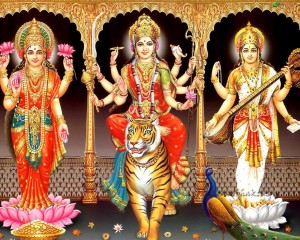
Following Pitru Paksha, the time for honoring our ancestors comes a much more joyous celebration. Tonight marks the first of nine nights of the Indian holiday of Navaratri (also spelled Navratri). Navaratri marks nine days of celebrating the goddesses Durga, Lakshmi, and Sarasvati.
It is time of celebration, dance, feast, and devotion. Friends and families get together to commemorate these nine nights. They attend large dances, called garbas, where they dance to songs about the goddess. Special prayers are recited to honor and worship each deity.
While there are outer activities done for these celebratory days, there is an inner ritual which also takes place. Each Indian deity, whether male or female, represents certain qualities or traits. There are also myths or stories for each deity which help highlight these traits. The stories serve as teaching tales for children when they are young and as reminders for adults for virtuous characteristics.
The first three nights are dedicated to the mother Goddess Durga. Durga represents righteousness and removing negativities from our lives. As the divine mother, she protects and cares for all, and removes those who wish to cause harm. She is both benevolent and fierce. She remains fixated on her goals and ever watchful of her surroundings. She is fearless and ready for action and is depicted as riding a tiger or lion. Durga has many appellations, including Kali, Amba, Chandika, and Parvati.
Following that are three nights to honor Lakshmi (luck-shmee), who is Lord Vishnu’s consort. Lakshmi is the goddess of prosperity and abundance. She represents wealth in both material and spiritual forms. She is beautiful and gracious. Lakshmi sits or stands on a lotus flower. The lotus is the flower which is laid at the feet of the Gods. She is dispensing gold coins, so she is not holding on to wealth, but spreading it widely.
The last three nights commemorate the goddess Sarasvati (suh-russ-vuh-tee). Sarasvati is the goddess of wisdom, knowledge, literature, and music. She is dressed in a simple white sari. White symbolizes purity. Knowledge which is obtained from a divine source must be pure. Sarasvati reminds us of the importance of the arts in our lives. She teaches us that knowledge is sacred, and one source of this wisdom is books. She holds a book in one hand and musical instrument called a veena in another hand. There is a mala (the Western equivalent would be a rosary) in another hand, to remind us to worship or recite a mantra. Mantras are usually passed on orally from teacher to student or from a Guru to a disciple.
When we worship these deities, we can take some time to reflect on these qualities within ourselves. How do we embody them? Do we call upon these virtues when we need them? Have we taken time in our lives to protect others, share our abundance and to deepen our knowledge? The holidays return time and again offering us new opportunities for both spiritual and personal growth.